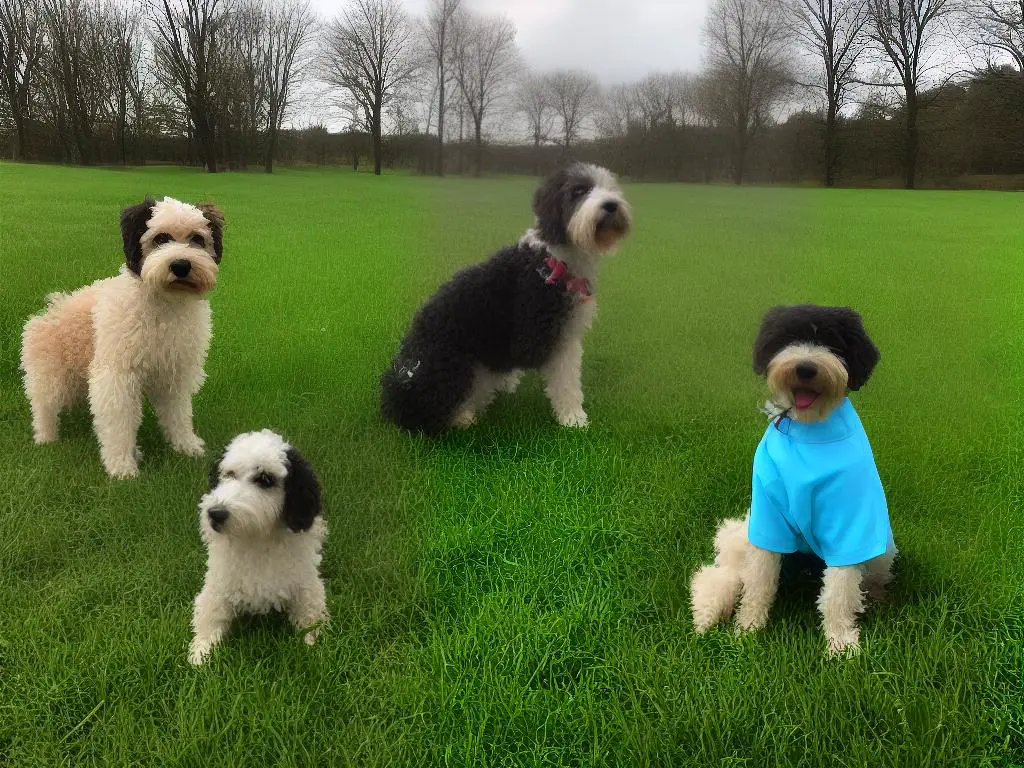Understanding the Double Doodle: Are they Hypoallergenic?
Dogs, man’s best friend, come in myriad sizes, shapes, and temperaments, adding their own wonderful brand of joy and companionship to the homes they inhabit. Among the wonderful multitude of breeds in existence, one unique mix stands out – the Double Doodle. Often praised for their manageable size and endearing disposition, double doodles capture the hearts of many pet lovers. However, one crucial factor that pet enthusiasts must consider before bringing these adorable canines into their homes is their hypoallergenic properties. In this exploration of the Double Doodle breed, we delve into key characteristics, hypoallergenicity, and the impact of these factors on allergic reactions. By the end of this nuanced journey, you’ll be equipped with the knowledge needed to confidently ascertain whether the Double Doodle is the right hypoallergenic breed for you and your family.
Understanding the Double Doodle Breed
Double Doodle: A Breed in Brief
The Double Doodle, a crossbreed between the Labradoodle (Labrador Retriever and Poodle mix) and the Goldendoodle (Golden Retriever and Poodle mix), inherited some of the most positive traits from each breed, including an affable and affectionate temperament, high intelligence, and hypoallergenic coat.
History & Origin of the Double Doodle
This relatively new hybrid dog breed emerged in the last two decades to reconcile the best qualities of its parent breeds. The precise origin and initial breeders remain unknown given its recent development.
Physical Characteristics
Double Doodles typically have a medium to large size body that falls in-between the sizes of its parent breeds. Adult Double Doodles range from 50 to 80 pounds and stand about 20 to 29 inches tall. Their eye colours can be blue, green, brown or amber corresponding to their coat colour which varies from cream, gold, black, brown and even multi-coloured.
Double Doodle Temperament
Double Doodles are known for their warm and friendly nature. They are especially popular as companion dogs, family pets, and therapy dogs because of their patient and gentle disposition. Highly intelligent and easy to train, they are also playful and love physical activities. Double Doodles thrive in the company of their human families but can be wary of strangers or new environments.
Care Requirements
This breed requires moderate exercise to stay in good mental and physical health. They are active dogs, so a daily walk and playing fetch or other games in a fenced-in yard are ideal. Double Doodles inherit a love for water from their Labrador Retriever and Golden Retriever parent breeds, so swimming can also be an excellent exercise for them.
Hypoallergenic Nature of Double Doodles
One of the significant selling points of the Double Doodle is its hypoallergenic coat. While there is no breed of dog that is 100% hypoallergenic, some breeds produce fewer allergens than others, and Double Doodles are considered one of them.
Health Considerations
Double Doodles are generally healthy breeds, but like all breeds, they can be subject to certain genetic health conditions common to their parent breeds such as hip dysplasia, eye disorders, and certain types of skin disease. Regular veterinary check-ups and a balanced diet can help keep your Double Doodle healthy and happy.
Reputable breeders commonly conduct thorough health tests on the parent dogs. This testing is essential as it significantly minimizes the possibility of health conditions being passed down to the Double Doodle pups. This testing regimen makes it pivotal for potential Double Doodle owners to meticulously select breeders with proven track records of health testing.

The Meaning of ‘Hypoallergenic’
Peeling Back the Layers of Hypoallergenic Dog Breeds
The term ‘hypoallergenic’ has its roots in immunology, referring to substances that have a lesser likelihood of provoking allergic reactions. When applied to dogs, hypoallergenic breeds are the ones considered less prone to provoke allergic reactions in individuals with sensitivities. However, it is crucial to note that no dog breed is entirely hypoallergenic. Rather, some breeds are prone to produce fewer allergens compared to others.
Dogs harbor allergen proteins in their saliva, skin cells, and urine, which when shed, adhere to their dander. The dander, comprised of dead skin flakes, can spread through the surrounding environment leading to allergic reactions in sensitive individuals.
What Makes the Double Doodle Hypoallergenic?
The Double Doodle is hypoallergenic due to its parent breeds: the Labrador Retriever, Goldendoodle, and the Labradoodle. While Labs are not considered hypoallergenic, both poodles and doodles are known for their hypoallergenic characteristics, including low shedding coats.
The poodle’s curly coat traps dander, reducing the number of allergens that get released into the air. On the other hand, doodles, such as the Goldendoodle and the Labradoodle, have inherited this low shedding characteristic from their poodle lineage. The combination of these traits makes the Double Doodle an excellent choice for those with allergies.
Living with a Double Doodle: Allergen Management
While the Double Doodle is a better breed for allergic individuals, it doesn’t eliminate the presence of allergens. Therefore, it’s crucial to manage allergens effectively. Regular grooming, including brushing and bathing, can help remove dead skin cells and trapped dander. Maintaining a clean home environment, using allergen-reducing cleaning products, and using a HEPA air filter can also minimize allergen concentration.
The Importance of Individual Allergy Testing
Although the Double Doodle is considered hypoallergenic, reactions to allergens can be highly individualistic. Some people may tolerate one hypoallergenic breed better than another. If you suffer from dog allergies, spending time with a Double Doodle before bringing one home is a sensible step. Keep in mind, hypoallergenic doesn’t mean allergy-free—it merely means a lower likelihood of causing allergic reactions.
Understanding Immunity and Allergies
Understanding immunity and how allergies work can also provide a better comprehension of the hypoallergenic term. The allergic reaction instigated by dogs isn’t due to the dog’s fur, but proteins found in their dander, urine, and saliva. These allergen proteins are identified as foreign invaders by the immune system of allergic people, causing symptoms like sneezing, itchiness, and even asthmatic episodes.
Details to Consider
Should you be a hobbyist or enthusiast considering the ownership of a Double Doodle, understanding the hypoallergenic characteristics of this breed and implementing relevant allergy management strategies are fundamental necessities.

The Double Doodle and Allergies
Diving into the Double Doodle Breed
The Double Doodle, an interesting cross between a Labradoodle and a Goldendoodle, boasts a vibrant and personable disposition, making it an excellent choice for a family pet. Usually ranging from medium to large in size, this breed comes in a variety of coat colors and patterns. Additionally, their distinctively curly or wavy coat not only enhances their charm but showcases another important aspect; their hypoallergenic traits.
Double Doodles & Allergen Production
Scientifically speaking, whether a dog breed is hypoallergenic or not is determined by the level of allergens it produces. Allergens are typically found in a pet’s dander, urine or saliva and can trigger allergy symptoms in susceptible individuals. Interestingly, no dog breed is 100% hypoallergenic.
Given their poodle heritage, double doodles may produce fewer allergens compared to other breeds, as poodles are often cited as one of the most hypoallergenic breeds. However, it is important to note that individual dogs within a breed can produce different levels of allergens. The double doodle’s hypoallergenic potential is, therefore, contingent on its unique genetic makeup and individual characteristics.
Anecdotal Experiences with Double Doodles and Hypoallergenic Properties
Owners and breeders of double doodles often report that these dogs are good for people with allergies. Anecdotal experiences suggest that many individuals, who usually react to dogs, reported fewer or no allergic reactions around double doodles. While such testimonials can provide a hopeful outlook, they should not overshadow the fact that everyone’s allergies are unique and can react differently to different breeds, including double doodles.
Tips for Allergy-Susceptible Potential and Current Double Doodle Owners
If you are susceptible to allergies but are considering bringing a double doodle into your home, it is advisable to spend time around the breed first to see how your allergies respond. Visiting a breeder or a friend who has a double doodle can give you a practical sense of whether having such a pet will be manageable with your allergies. In some cases, allergy shots or medication may also be a workable solution.
In the case you already own a double doodle and are struggling with allergies, strategies such as regular grooming of your dog, maintaining a clean home environment, and investing in a high-quality air purifier can help mitigate allergic reactions.
Conclusion: Double Doodles and Hypoallergenic Considerations
Determining whether double doodles are hypoallergenic involves both understanding the scientific context of allergen production and considering anecdotal experiences from owners. Adding a double doodle to a home with allergy-prone individuals requires careful consideration and possibly, an adjustment period, but might be feasible with the right mitigation strategies and a commitment to a regular grooming routine.

As we have explored, the term ‘hypoallergenic’ goes far beyond a mere marketing buzzword, playing a substantial role in influencing the compatibility between humans and their prospective pets, especially in the context of allergies. The Double Doodle breed, known for its adorable features and amiable demeanor, now stands illuminated in a fresh light, evaluated not just on basis of their physical and behavioural traits, but also their interaction with the allergenic spectrum. However, every dog, including Double Doodles, is individual with unique characteristics – hence, always remember to spend time with your prospective pet to ensure it’s a perfect match. Allergies or not, may your journey with your furry friend be filled with the joys of mutual companionship, boundless play, and the creation of priceless memories.
